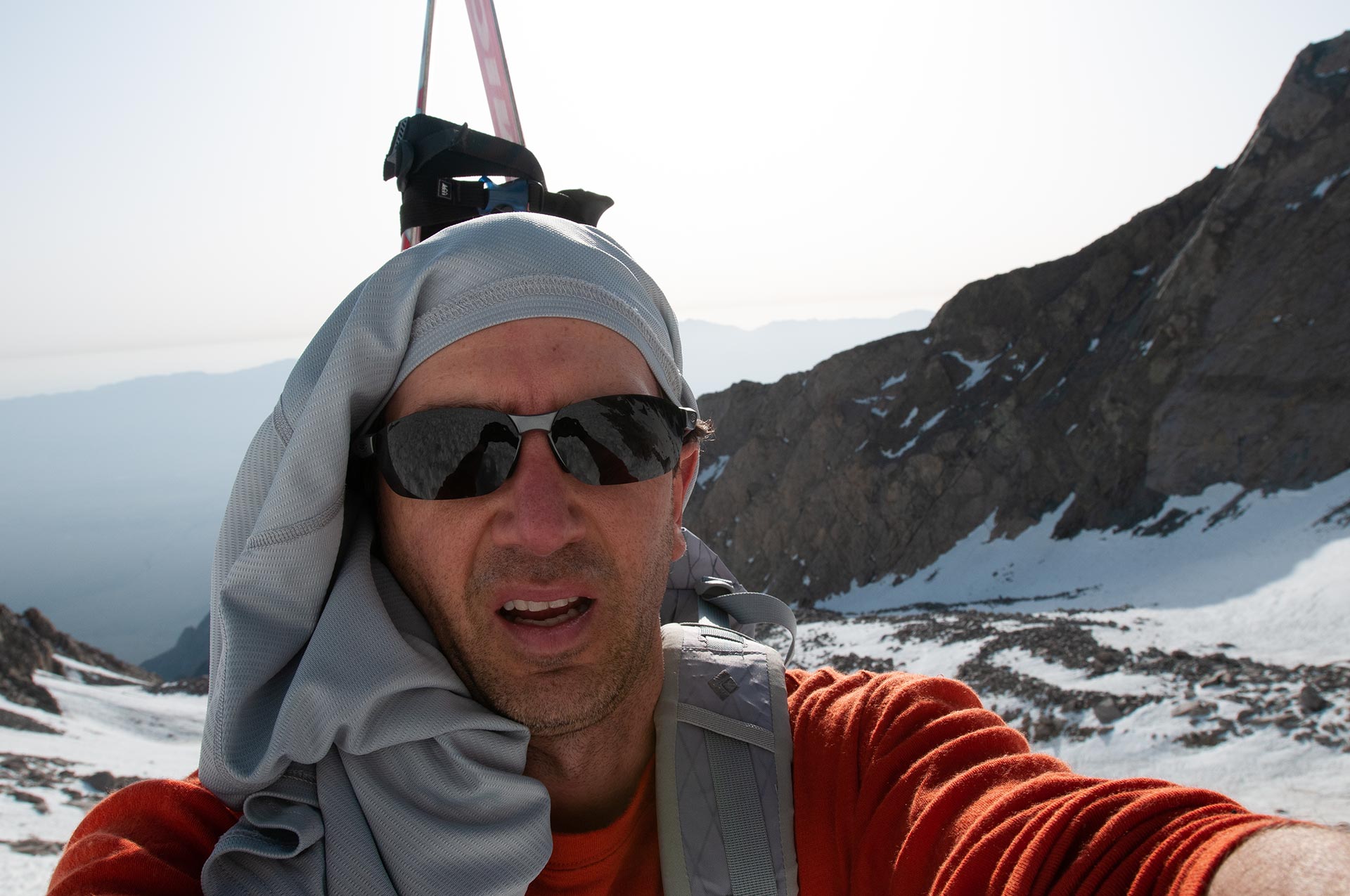Mount Muir: The East Buttress
A Discontinuous Ski Descent of the 'Unskiable' East Buttress
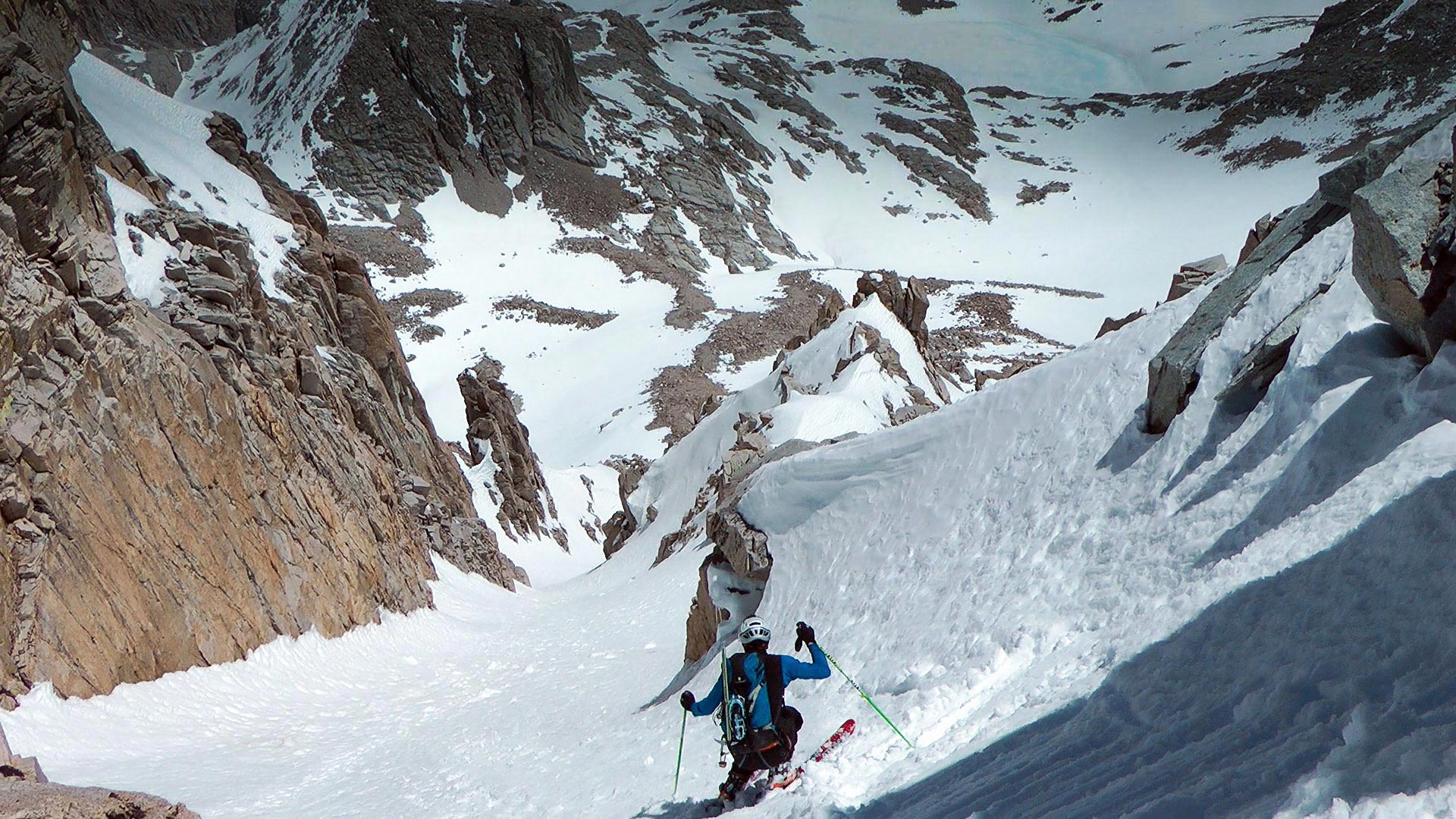
Unskiable
Mount Muir, California — In those many sleepless nights, I began to wish I'd never seen it. I was having a nice, easy backcountry skiing season, perfectly ordinary, perfectly fine. I didn't need any trouble.
I didn't need to do anything fancy; I didn't need to do anything special. I didn't need to be obsessing about hanging snowfields and massive, dead-drop cliffs. And I especially didn't need to start a take-no-prisoners war between prudence and ambition.
Of all California's fourteeners, Muir is perhaps the least impressive. Seen from the west, Mount Muir's 14,012-foot summit is but a minor pinnacle off Mount Whitney's southern shoulder.
So un-arresting is that western view many people question whether Muir is, in fact, a mountain—or just a lesser part of the Whitney massif. Yet while Muir's apex is itself unimpressive, below that summit is quite a remarkable feature indeed: the mountain's massive and imposing east buttress.
As bold geological features go, Mount Muir's east buttress is a prominent one in a region hardly bankrupt of competitors. En route to Mount Whitney via the main trail, even the most exhausted hikers must surely find themselves taken by the sight of that dramatic thrust of granite rising high above Trail Camp.
Where Muir is concerned, the east buttress is the mountain. It is what justifies calling Muir a peak rather than peaklette, and what makes it worthy (if arguably) of its namesake.
Some years after first climbing Mount Whitney, and learning of Mount Muir's existence, I returned to climb Muir via the reasonably-tame west face. And I clearly remember clinging to Muir's tiny summit while peering down its shockingly-exposed east face, surveying that magnificent buttress with a gaze both wistful and relieved.
As a skier, I have looked at many mountains, and I can tell you that Muir's difficulty level is extremely easy to categorize: it is unskiable. Much as I want to ski all of California's fourteeners, I've accepted that some will forever thwart that goal. Some are skiable, and some are not.
Muir falls into the latter category.
In fact, even if you adopt a generous standard, Muir remains stubbornly unskiable. Perhaps someday I'd carry skis up Trail Crest and ski some pitiful scrap of something on the west side of the "mountain" just to say I did. But I knew I'd never truly ski Muir, because that was impossible.
Or so I thought until Spring 2010, when word came that an ambitious and gifted Colorado ski mountaineer named Chris Davenport had just skied it.
Dav's Line
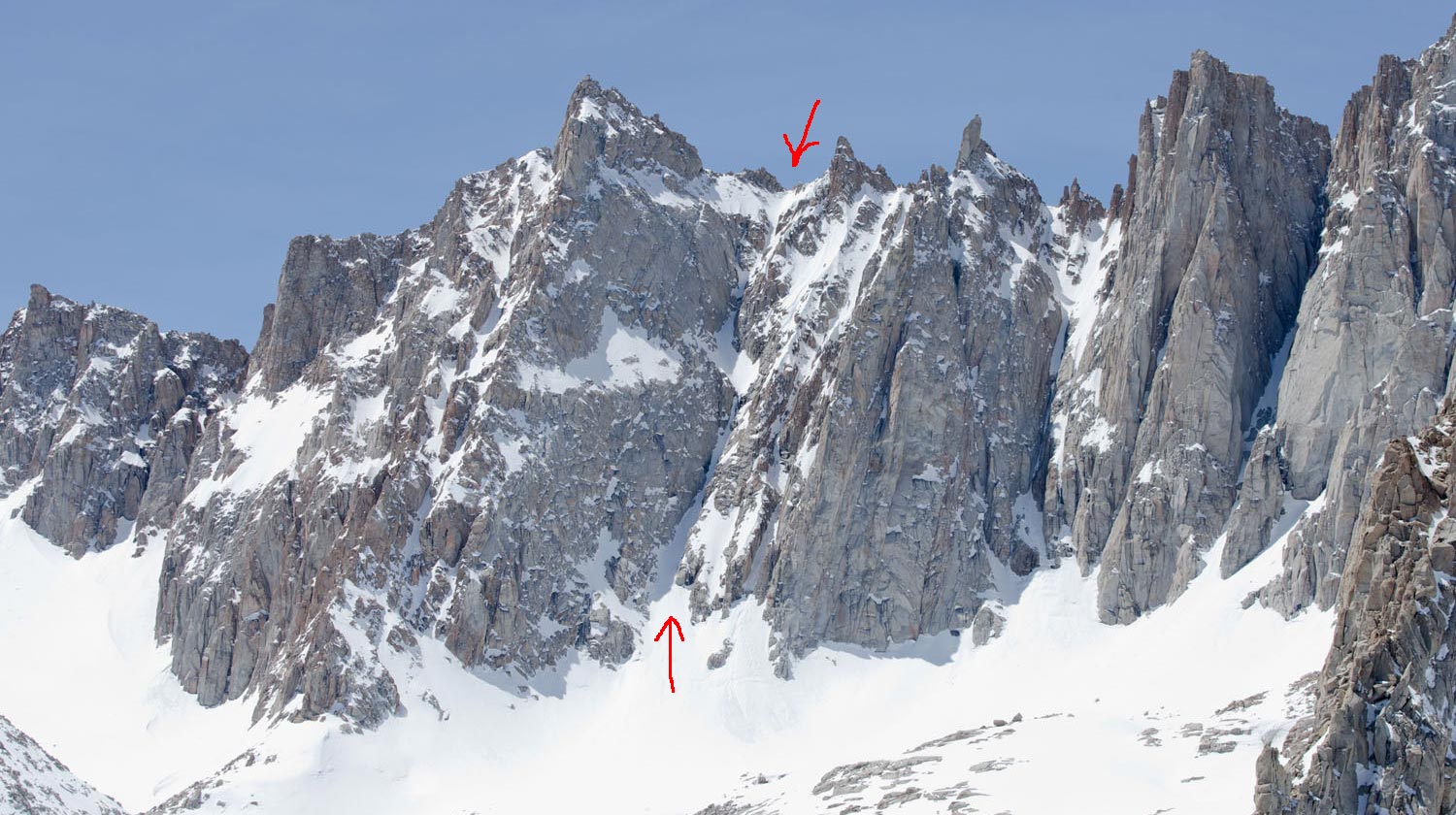
April 17, 2011. SoCal ski mountaineer David Braun and I admire the view of the Whitney Crest from the summit of Thor Peak. We're here by accident, in the sense that we had intended to ski an entirely different mountain, to the north, only to be turned back by unexpectedly poor conditions.
So were are here instead. The defining characteristic of the 2011 Sierra winter has perhaps been its erraticism. Huge storms, huge snows, huge winds, outrageous heat waves. The result is a snowpack of the ultimate capriciousness.
Some faces look as bare as the worst drought year. Other areas see historic snow levels. And so we are here atop Thor Peak, something we've climbed today mostly just for sightseeing.
Along for the ride is my heavy DSLR and giant zoom lens, which Dave has graciously agreed to carry specifically to capture those magnificent Whitney Crest views.
Dave and I take turns snapping shots of Whitney landmarks...and then I happen to notice we also have a striking view of Mount Muir to our left.
Naturally, I immediately begin to look for the Davenport line—or, more properly, the Davenport-Pondella-Boyer line, as Dav was accompanied by two locals, photographer Christian Pondella and Mammoth skier/alpinist Ryan Boyer.
Given as I say that Mount Muir is unskiable, you might wonder how it is that Davenport and company pulled off the impossible and actually skied it. The answer is...they didn't.
At least, not if you take an extremely strict and grinchy view.
The Davenport line (or the DPB line, if you prefer) descends a narrow, discontinuous couloir adjacent Mount Muir's north face.
Dav, Pondella, and Boyer were forced to rappel twice during their ski descent, and skiing from the summit of Mount Muir via the route was not possible. And if that's not enough to call into question the definition of 'skiing Muir', the entire line, bold and beautiful as it is, arguably sits not on Muir itself but rather adjacent to it.
Defining what is and is not a ski descent turns out to be a matter of no small debate.
Believe it or not, there is disagreement over who first skied Mount Whitney, because Orland Bartholomew, who stood atop Whitney on his skis in 1928, wasn't considered (by some) a good enough skier to ski Whitney. Bartholomew's descent-while-wearing-skis, they apparently would argue, just wasn't 'skiing'.
I myself would argue the spirit of skiing matters a great deal more than the technicalities, and so I will happily if jealously credit Davenport with skiing the unskiable Muir, as least as best as mother nature has thus far permitted...
But look at this: here, to the left of Davenport's line, my naked eye seems to be spying a thin ribbon of snow connecting Muir's south shoulder all the way to the moraine at the base of the east buttress.
Quickly I grab the Nikon from Dave and begin snapping closeups, section by section, to be studied with much intensity when I get home to my computer screen. My intuition says that what I'm seeing right now can't possibly be real—there can't possibly be a way to ski Muir's east buttress.
Even so, my heart starts to flutter. A previously-unknown ski descent on the as-Muir-as-it-gets east buttress? A true first descent—maybe the true first—on a California Fourteener? It's like a glimpse of El Dorado, riches and temptation unbounded.
Allow me to stop this report for just one moment to note that, while there will indeed be skiing soon to come, for now we will be exploring a few other diversions, beginning most notably with myself.
Among my vanities is my sense that I am a person and in particular a skier who makes things happen. I understand I operate in a fairly small corner of the ski mountaineering universe, but nonetheless I like to think I have a knack not just for talking about things, but actually going out and doing them (see, for example, The Couloir to Nowhere).
I also like to flatter myself by imagining I have a gift for finding things that are unlikely or otherwise unseen by other people (see: Lone Pine Peak).
And of course there is also my high regard for my skills as a skier.
I am not so deluded as to call myself a climber—though perhaps on snow I am at least not completely incompetent—but when it comes to skiing I have become, over the years, oddly capable when it comes to making pretty turns on terrifying pitches.
Uniquely at odds with that ability is my much-cherished sense that I am an eminently reasonable and rational person, conservative and cautious to the core—a belief that will soon be sorely tested.
Back home in my Los Angeles apartment, I surveyed my photos of Mount Muir with great interest. But those high-zoom shots from Thor Peak quickly revealed hints that the finger of snow I'd seen on Muir's east buttress was not continuous.
Distance compresses perspective, smashing objects together so that they appear to be adjacent, or even merged.
What looked to the eye like one thread of snow connecting top to bottom was revealed by the 17 mega-pixel sensor of my Nikon as not one but three separate snowfields, each separated by two discontinuities of unknown consequence.
I say 'unknown', but there wasn't much to call a mystery. Any discontinuities on Muir would likely involve sheer granite and horrific exposure. There would be no ski descent of the east buttress, obviously, because the east buttress was unskiable.
To be honest, in addition to disappointment I also felt considerable relief. No skiable line meant no risk-taking—no sticking my neck out there in unknown country.
And so perhaps the matter should have ended but for another quirk of my character: stubbornness. Because if there was a skiable line hidden there, against all available evidence, it was almost certainly a first descent waiting to happen. A First Descent on a California Fourteener—the holy grail of Sierra ski mountaineering.
I just couldn't let the possibility go. And so I began searching through my photographic archives, looking to see if I had any other views of Mount Muir taken on other occasions. What, exactly, happened at those points of discontinuity, I wondered?
What would I find, if, for some odd reason, I and my skis just happened to climb up there?
Reconnaissance
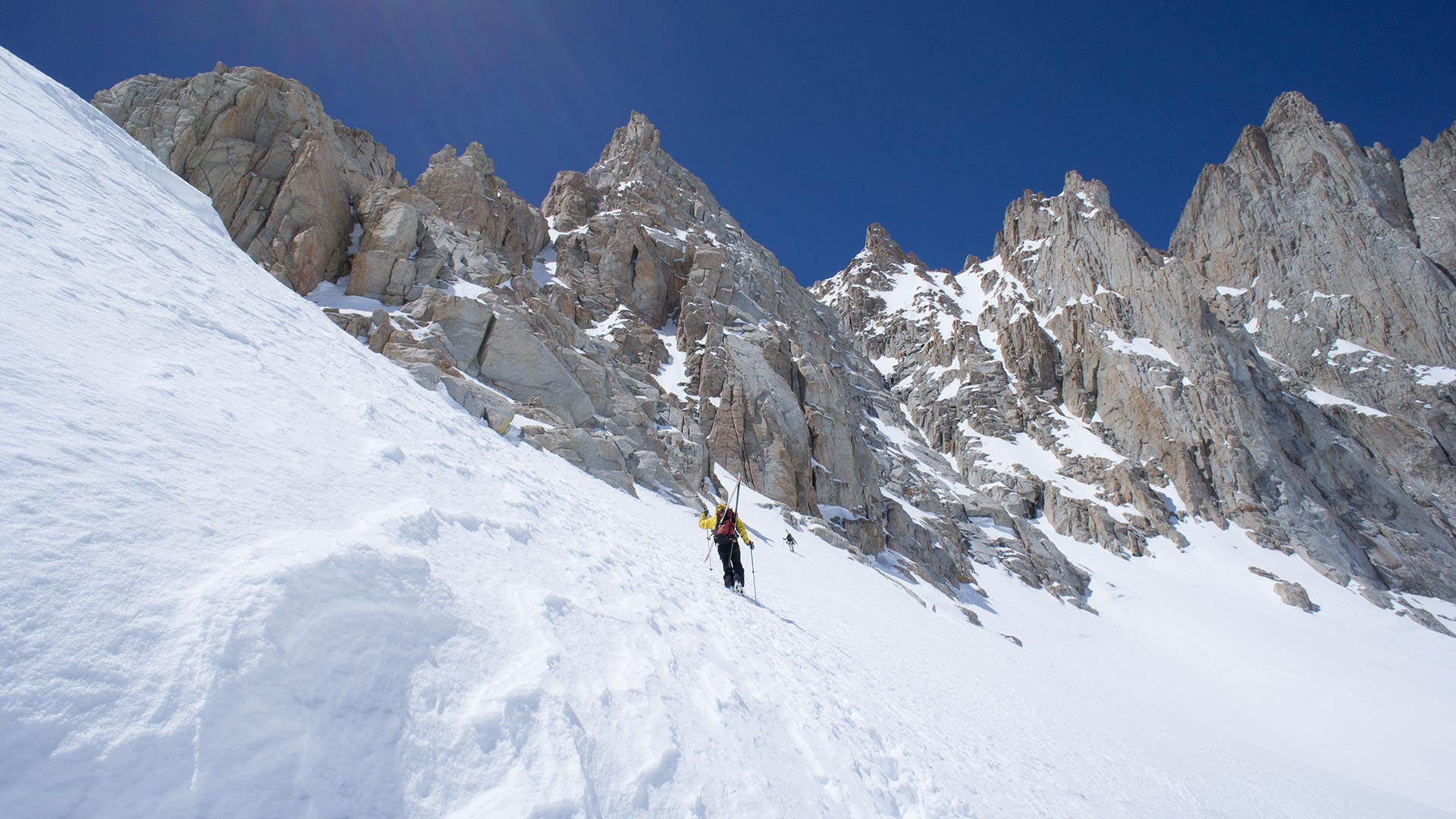
Trevor Benedict and Dave Braun approach the East Buttress
Curiously, it is a photo I took from the summit of Lone Pine Peak that reopens the door of possibility on Muir. When I find it I sit up at once and squint intently at my monitor screen.
The photo reveals a dramatic hanging snowfield angling across Muir's southeast face, connecting—maybe—to the couloir along the lower east buttress as seen from the top of Thor Peak. By mentally piecing together the information in the two photographs, I realize the route's 'discontinuities' may actually just be steep, snowy steps.
Maybe.
Unfortunately, the view I need is the one I don't have: Muir's south face from the vicinity of Trail Crest. And so, a few days later, I find myself returning to Whitney Portal with Dave Braun and also Trevor Benedict to further scout and possibly even try to ski the east buttress route.
Trevor, a former Aspen ski patroller, is close to my ideal of a backcountry skiing partner: fit, skilled, and conservative.
I figure he's had more than enough safety protocols drilled into his head over the years to keep Dave and I honest.
Maybe.
But on this day the big story is the weather: clear and bitter cold.
It's May 2. Here in the Southern Sierra we ought to be worrying about soft snow and wet slides. Instead, tricky Mother Nature has thrown us an overnight low of zero, forecast high at 12,000 feet a chilly 24 degrees.
The snow everywhere, even in the sun, is brick-hard. North faces look unnaturally smooth, with a shiny glaze that suggests unskiable ice.
But as we approach the base of Muir's east buttress, the snow turns wintry, soft sticky powder just right for steep dabbling. Maybe we'll be able to ski a portion of the route, or even more?
Maybe.
We stop to eat lunch just below the start of the route, below what I'm calling the Exit Couloir—for a skier, the couloir that provides the exit from the hanging snowfields on Muir's southeast face.
The view is intimidating. The view is insane.
I am thinking to myself, if this route has never been skied before, there is a very good reason why. Unskied big lines in the Sierra fall into two categories: those no one yet knows about (rare) and those no one in their right mind would want to ski.
Muir's east buttress may or may not belong in the first category; it definitely belongs in the second.
Still, lunch concluded, we gamely press on, wrapping around the mind-blowing base of the east buttress, then climbing up the apron below the start of what we think is the exit couloir.
The pitch starts steep and quickly gets steeper.
As the angle shifts toward 50° the snow abruptly hardens. I know at once our ski plans are over.
We go a little higher, hoping the ice will go away. It doesn't. And the angle continues to increase, now passing 60°. Trevor shakes his head; he's had enough. So have I. Dave pushes on, wanting to see if we're at least in the right spot. The verdict: indeterminate.
Just out of sight above is an exposed rock garden. Maybe the Exit Couloir connects above. Maybe it doesn't.
The prudent thing to do is turn back, and that's what we do. Dave down-climbs back into view. Carefully, he snaps into his skis and steps through an icy choke. Then he bangs out a fearless set of turns on an exposed spine, whooping when he hits the softer snow below.
I'm next, showing a lot less aggression through the icy section, feeling much happier when I hit the powder stash, stunned the whole way down by the crazy-crazy steepness of it all. Trevor skis down to join us on a wonderfully-flat patch far below the apron.
Am I a little bit shell-shocked? Absolutely. Muir's east buttress has just delivered us a classic Sierra smackdown.
Of Sample Paths and Uncertainty
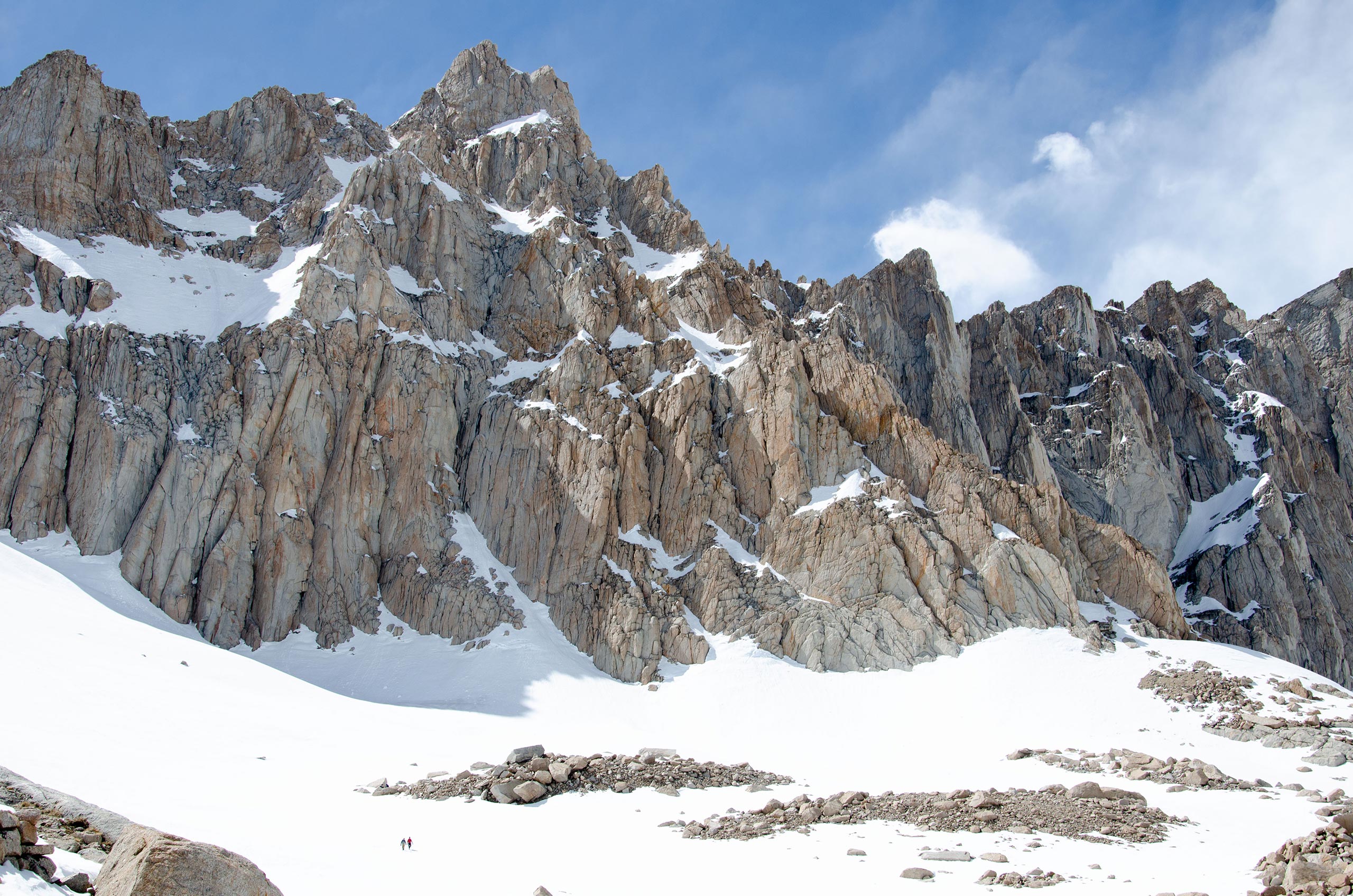
We three part company after collecting our stashed gear at the base of the east buttress. I traverse toward Trail Crest with the Nikon, wanting to get one more look at Muir's southeast face.
And that look proves to be the last piece of the puzzle. From below Trail Crest, looking through the window of my zoom lens, I can see Muir's hanging snowfield does indeed connect to the Exit Couloir. When I get home I check again, on my computer screen, and now I'm sure of it: the route exists, albeit with difficulties.
And I find myself wishing, damn it, that the route didn't go.
Because what the hell am I supposed to do now? The week passes slowly. At night, I lie awake in bed, tormented by images of Muir's discontinuous snow and horrifically steep granite. By day, when I'm not chasing my children about our home, I re-read sections of Nassim Taleb's Fooled by Randomness (@Amazon) . As preparatory material for a man contemplating an extreme ski descent it is perhaps the best and worst possible choice.
Taleb argues we should judge an outcome not by its actual result, but rather by its expected result: the sum of all possible outcomes, multiplied by their respective probabilities. It is an interesting way to view reality, one in which a small town dentist's earnings vastly exceed that of a lottery winner's—and also a particularly illuminating way to analyze the game of Russian Roulette.
If my brain is good at anything it is good at rationalization, and this Muir proposal is the rationalization mother lode. It's got it all: a chance to do something significant, consequential, extraordinary... In my mind's eye I can already see the photos, the video, the story I'll come back with. All I have to do to get there from here is stay alive.
I can rationalize the problem all I want, but I already know there is no way to justify taking the risk of skiing something like Muir's east buttress. Too much lies beyond my control. However great my skills, my judgment, my experience, if I choose to do it I will be betting my life on a roll of the dice. And for what? Will it make me famous? Rich? Happy?
I like to think of myself as a family man, an informed and rational human, one who weighs risks and rewards carefully, one who considers not just the result but the expected result of any trial. But that is all blowing up in my face, now. I am, it turns out, not at all the person I thought I was. I'm turning out to be someone quite different. A fence-swinger. A shoot-the-mooner. A bet-it-all-on-black.
I want it.
That's the bottom line. It makes no sense whatsoever. It is stupid, pointless, irresponsible on an order of magnitude beyond anything I've ever done. But none of that matters. I want it, and I will pay any price—any price at all—for a chance to have it.
The Rock Garden
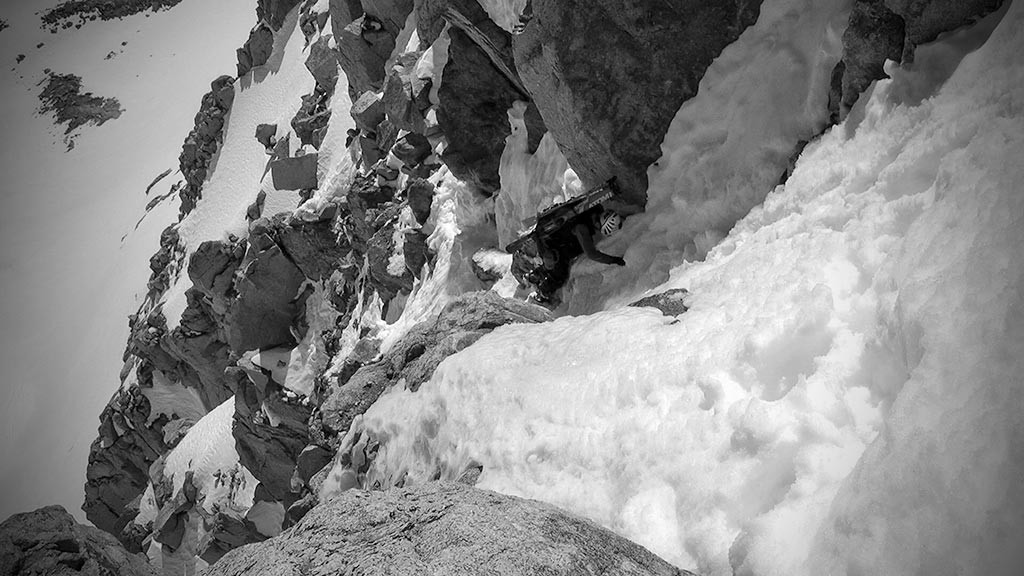
May 7, 2011. Sugary, unconsolidated snow covers ice-bound rocks above mind-numbing exposure. Dave Braun and I are a quarter of the way up Muir's east buttress, elevation approximately 13,000 feet.
While my scouting-photo attention had focused on the snow-step discontinuities high above, Dave and I are discovering the route's true crux may well be right here instead, on this awful traverse.
We have successfully climbed past the point where we turned back the week before, and we can now see where we need to be—the Exit Couloir continues invitingly above—but the way is blocked by a short, ugly, utterly-exposed traverse I'm calling the Rock Garden.
I'm right in the middle of it, skis on my back, pondering the now-apparent realities of my decision to revisit Muir's east buttress.
It really doesn't pay to look down right now. There is nothing in that direction that will be the least bit helpful in extracting ourselves from this present predicament.
It is best, really, to go someplace else right now, switch off all but the most essential brain functions.
Once upon a time, in summer, I tried to climb a route I had skied in the San Francisco Peaks' Inner Basin in winter (we called it Powell's Prayer). What had been an exciting ski descent proved to be a harrowing free climb: loose rock that crumbled every time I put my hands on it.
You get up those routes—after you've first suitably reproached yourself for your own stupidity—by narrowing your vision until you exist only in a tiny bubble.
The entire universe contracts until it fits within a radius of perhaps three or four feet—only what is immediately within reach. Nothing else exists. Here within our tiny space, mind and muscles work out the various combinations of moves required to advance to the next puzzle, and the next, and the next, and so on.
The fear we put into a little box and seal it far, far away, where it can do no harm.
As I say: I am no climber. I know enough to know I shouldn't be here, but that knowledge, too, is useless right now, so I seal it away, far, far away, working only on finding better snow for the axe, a better edge to grasp with a sopping-wet hand, a better step on which to place the grinding, scraping points of my aluminum crampons...
Difficulty at this level of severity so early in the route leads the mind to veer toward hopelessness. Stay clear of those thoughts! Stay clear of thought, altogether. For whatever reason, I have climbed myself into this situation, and now I must climb myself out. That is the mantra.
There is no one and nothing else that can help me right now.
The Southeast Face
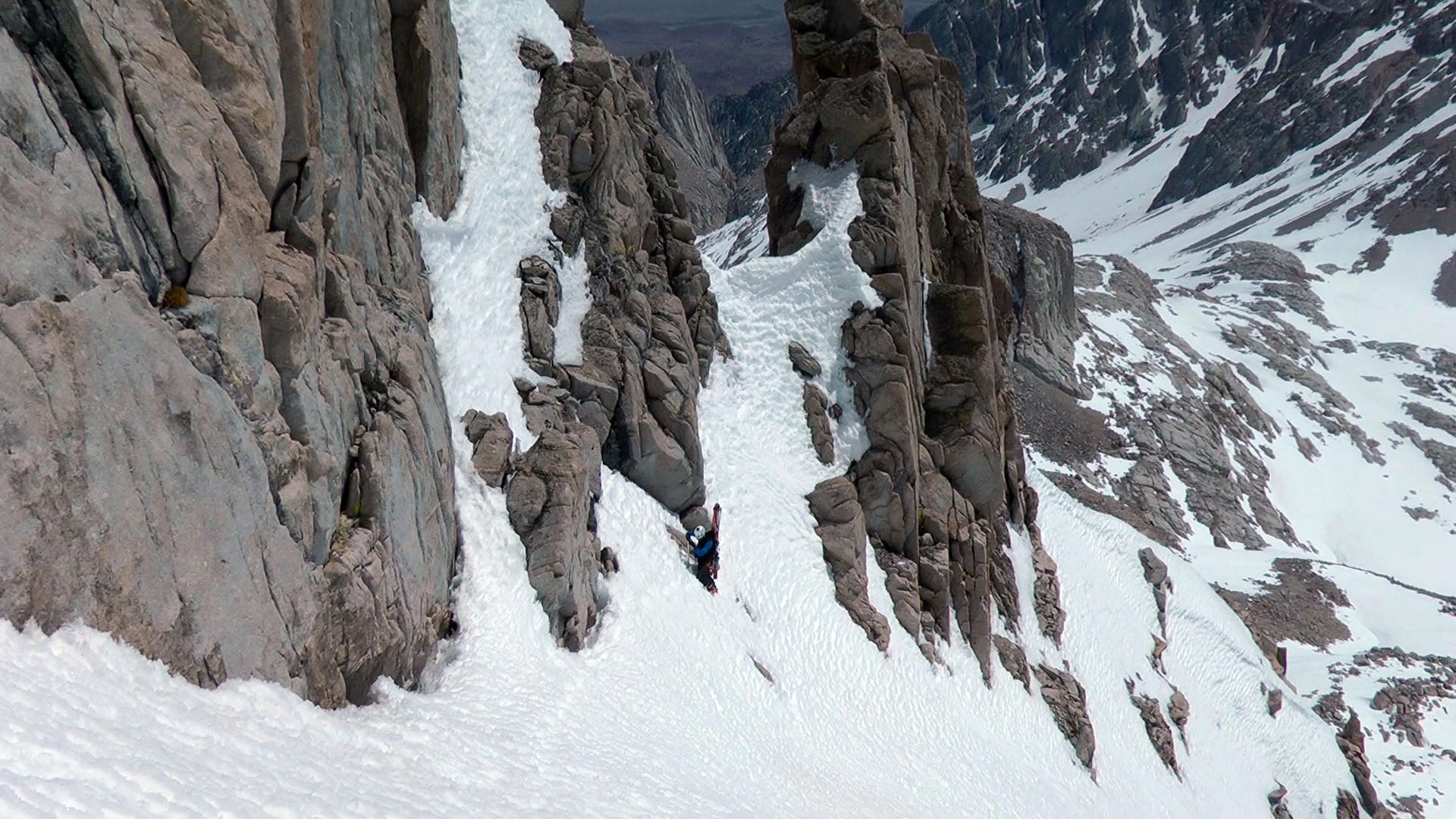
Though Dave and I have safely passed beyond it, our scramble across the treacherous Rock Garden has rattled me. Yet if we are to ski the route, we will be forced to repeat it, in reverse.
Back on snow on the upper Exit Couloir, it is possible once again to catch one's breath and imagine we are actually on a ski route, though of course any skiing that occurs from this point onward will be somewhat akin to a high-wire act.
I am having some doubts, however, about that possibility.
Perhaps, I console myself, if—when—we reach Muir's shoulder high above, I'll abandon the ski descent and make for the safety of the Mount Whitney Trail and Trail Crest instead.
As for Dave, he seems to have taken to quietly editorializing all of the route's difficulties.
The snow quality he criticizes with particular intensity, as he keeps finding a vexing mixture of wet snow and dry loose powder—particularly at those sections of the couloir where the difficulty increases.
Dave also expresses concerns about wet snow avalanches, which are certainly valid, but which seem at this point a bit like buyer's remorse to me.
We've already cast the dice on this route. It just remains for us to read the outcome.
Still, of the two of us Dave is clearly the one who's enjoying himself, comments aside. A touch of gallows humor seems to have found its way into his observations, while I remain clenched in a somewhat more grim silence.
Topping the Exit Couloir proves a bit spicier than we were expecting. This is a theme that will repeat itself quite a lot, in fact, as we continue to progress higher.
These short crux sections inevitably involve crazy-steep pitches and mind-blowing exposure, sprinkled with difficult collapsing snow that sends both of us scrambling for firmer ground.
Where the snow is firm, I sink my axe's 60cm shaft all the way to the head with each and every step, providing at least the illusion of a secure belay. When it gets dicey Dave heads for rock and I try to stay on snow, and when that works less than ideally for either of us, which is often, we just keep going, because that's all we can do.
Crucially, our photographic scouting is proving, piece by piece, correct.
Everything depends on us correctly finding the 1st Step and its excruciatingly-narrow passageway to Muir's southeast face, and there it is atop the Exit Couloir, just as we'd hoped.
So too is 2nd Step and its outrageous pillar. Each comes with its own difficulties, and the constant unreality of the southeast face's exposure, but I know we can do this, now. I know we're going to get to the top.
Muir's Summit
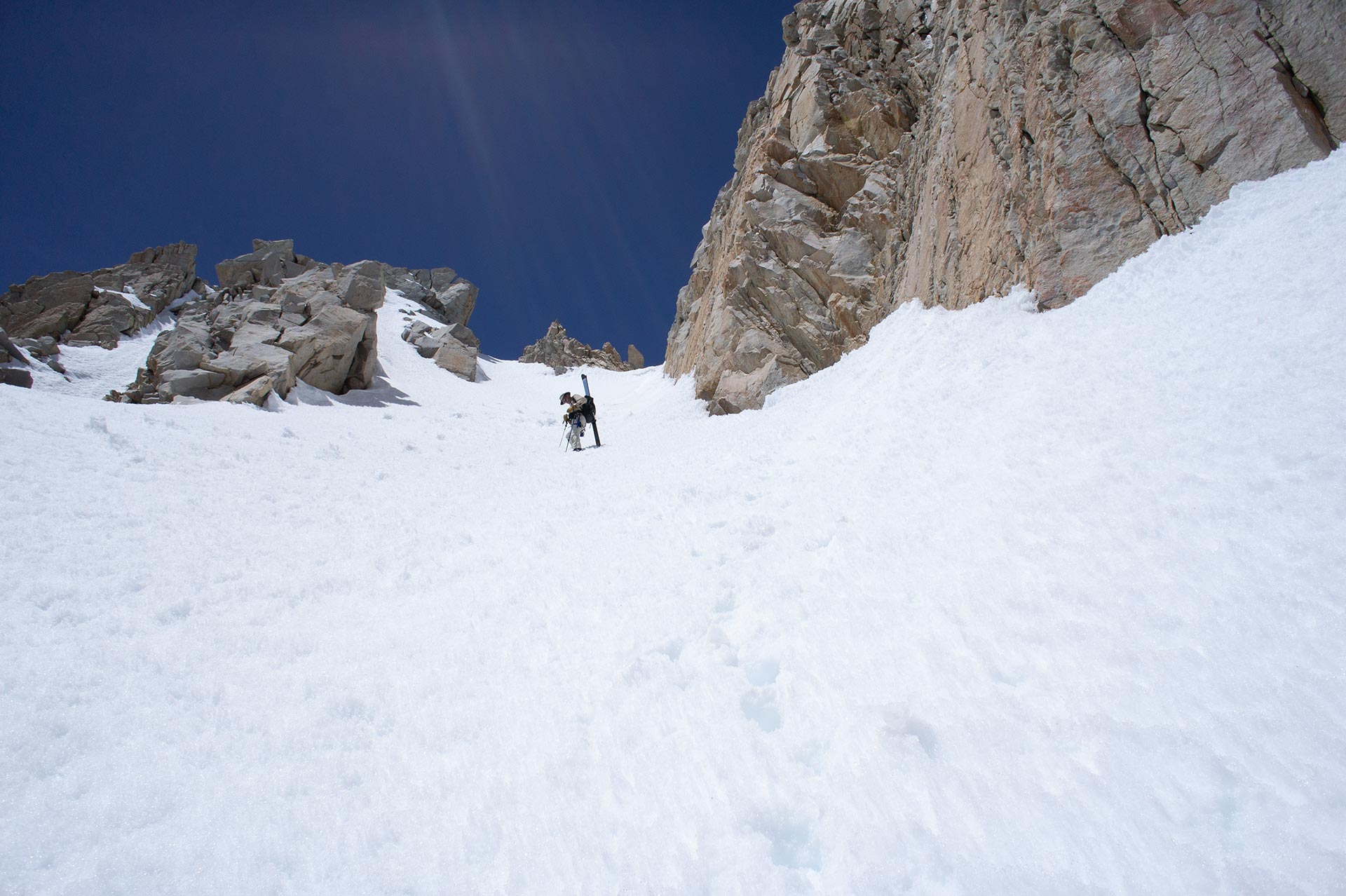
It is 12:08 p.m when Dave and I reach the top of Muir's south shoulder and the High Sierra Crest. Mount Muir's 14,012-foot summit is a short Class 3 scramble above.
Just a short walk westward and down is the Mount Whitney Trail—an escape route, should either of us wish to take it. Also westward is the expansive view of the incomparable interior Sierra, countless white snowy peaks gleaming in the bright Southern California sunshine.
We drop our backpacks, unstrap our skis, glance alternately east and west, option A, option B.
"Well," says Dave.
"Well," say I.
That fierce dropoff to the east reminds me of a climbing magazine photo: verticality so extreme my brain struggles to make sense of it.
But the snow looks inviting, even though I know it's all hanging over the southeast face's massive cliffs. And the sight of my skis seems to awaken a new emotion in me, one previously dormant but which now begins to rise:
Anticipation. Excitement...
You don't get many chances like this.
Life keeps our feet firmly rooted in the mundane most of the time. It is only on those rarest of occasions that we get even a chance to try to climb up and touch the sky. Do we dare take it?
Of course we do. Dave and I both know we're going to ski this mountain, hanging snowfields, steps, and rock gardens be damned.
On the subject of ski descent details, there is no point in carrying skis to the summit, as there is only bare rock above us, and the south-aspect snow below is getting softer by the minute, so we agree we'll begin our descent right here, right now, from the top of Muir's shoulder. As for speeches and poignant thoughts, we'll save those for later.
Now it's time to ski.
The Upper Balcony
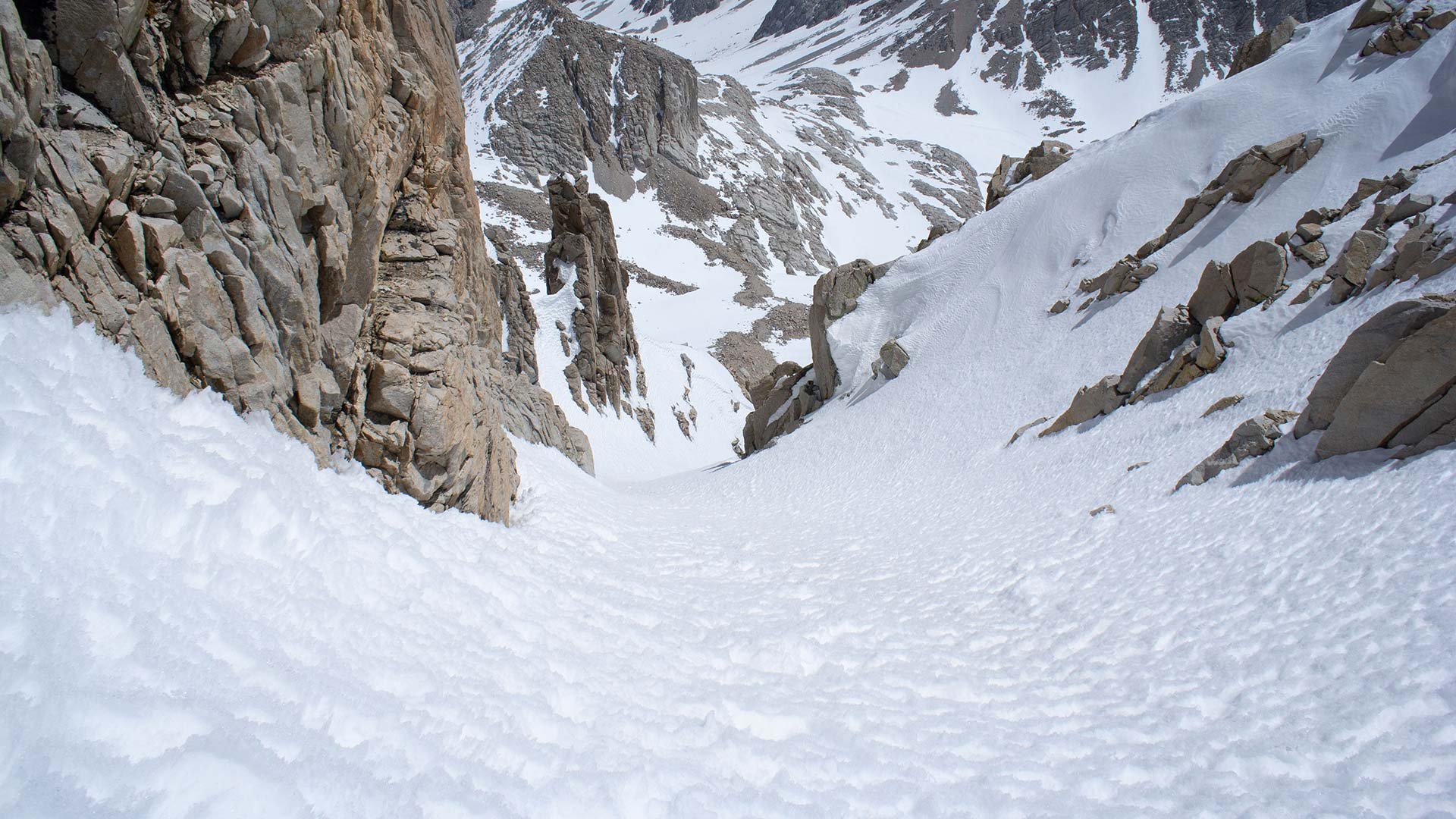
Our route today consists broadly of two skiable sections—the southeast face's dramatic hanging snowfields, and, far below, the east buttress's formidable exit couloir.
A truly outrageous pillar (which we call the 2nd step) divides the hanging snowfield into upper and lower balconies, while the "1st" Step connects the southeast face to the exit couloir, which is itself divided by the dreaded rock garden.
With the southeast face's softening snow motivating us to get moving, we snap into our ski bindings and drop into the upper balcony.
The transition from climbing to skiing is for me a happy one.
Despite the route's considerable objective hazards, with slippery sticks strapped to my feet I feel right at home here, at last in my element.
The soft snow also affords us a measure of tolerance when it comes to mistakes, but at the same time raises concerns of wet slides, which could sweep us right off the mountain.
So, my first turns are cautious, done with careful monitoring of the snowpack above me. When the snow begins to slide, in small rushing cascades, I quickly traverse away from the fall line, watching, waiting for the movement to stop.
I film Dave passing by.
His turns as always are bold and solid, as if he were born to ski this mountain.
The upper balcony is kind enough to offer perhaps the most moderate skiing on the entire route, with a modest 40-45° pitch, and the fatal exposure at Second Step hidden (initially) by the walls of the gully.
One can ski this section of the route and feel entirely at ease, as I do now, savoring the magnificent edge-of-infinity views and the electric sense that we are flying as much skiing.
Ah...but second step is approaching!
Think of it as a knife-blade covered in snow. Sitting between a sheer cliff and a striking granite pillar, Second Step provides a critical connection between the upper and lower balconies.
Climbing up, Dave and I were stunned to discover that the 60° snow on the step's lower side was actually the gentler pitch. To get up, Dave built steps by hand, using wet surface snow to harden the snow into a makeshift ladder. 2nd Step on this, the high side, is even steeper, and here at the base of it there is no mistaking the immediate and dire exposure below. As I watch Dave ski to a stop beside me, his gaze is fixed on the rolloff below, and his expression, I must say, is as focused as I've ever seen it.
Yes, there it is—the void, in all its glory.
Skis must come off here, to be replaced by axe or whippet and crampons, so that we can climb back up and then down the step to regain the skiable lower balcony. This will be the first of several such transitions, and they will all prove to be mentally withering, as they occur in the most precarious of places, with the gravest of consequences.
Dave goes first. I follow. Moments later, I'm sitting astride Second Step, one leg to either side, my butt cooling on as crazy a perch as I've ever known. I take in the views, bask in the sun, wait as Dave on the other side kicks out a platform and then snaps back into his skis.
The Lower Balcony
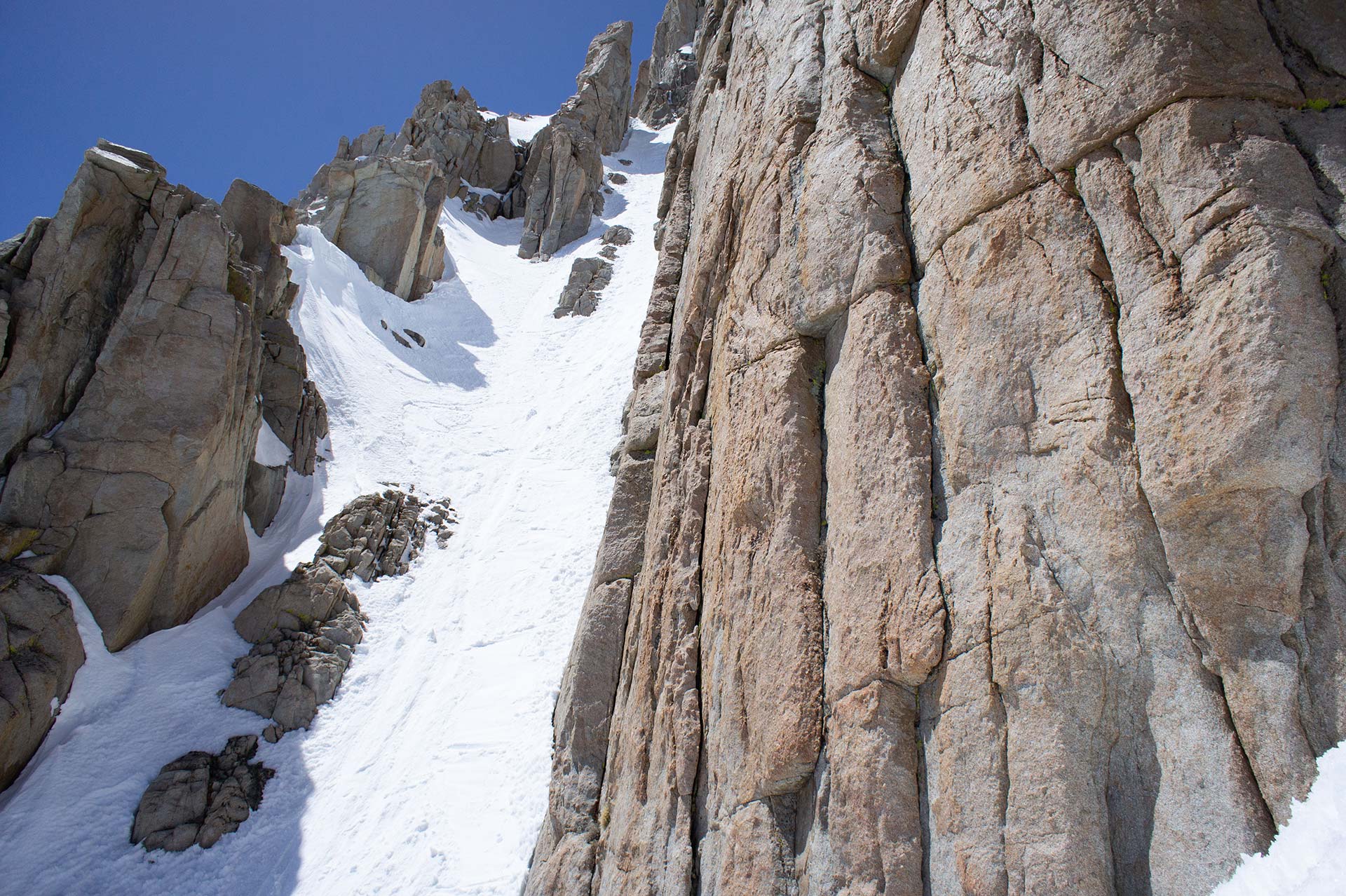
In contrast to the relatively (if deceptively) moderate slopes of the southeast face's upper balcony, the lower balcony is steeper, and its exposure far more evident.
Snow quality remains soft but manageable. However, as we're discovering, one of the more grinding aspects of skiing Muir's East Buttress is that, without fail, it gets harder the farther down you go.
The steep snow just below Second Step makes for a tricky transition back to skis.
I sink the tails of both my skis into the snow, creating dual belays for myself. Then I do my best to kick out a platform. A short but tense few moves later, I'm back to the pleasures of skiing, en route to First Step and the dreaded Exit Couloir.
On skis, the moves are effortless, the sequence always the same: test the snow. Feel the edges. Reach down with the pole, pulling the body out and away from the hill. Feel that uphill ski, transfer the weight to it, pull the downhill ski up as the body rotates and falls downhill.
A quick pivot and we're going the other way. Reach down with the other ski pole and do it all over again.
In some ways this entire experience has the disorienting, disconnected feel of a dream.
We are forced to selectively attend to reality here. The clockwork motions of making turns consume my consciousness, while more philosophical thoughts must by necessity be pushed away.
Still: what the hell are we doing here?
How it is possible that two men and skis should be traveling so far from home, through such a relentlessly vertical landscape?
Or, perhaps most directly, because it can be skied, does that mean we should be skiing it?
Dave and I descend lower, now nearing First Step and the connection to the Exit Couloir. Here, I find thoughts of the route below more difficult to suppress. The rock garden—that damned rock garden. How I wish I could keep my skis on, rather than face it again via axe and crampons.
Once again, another transition back to spikes.
At the bottom of the narrow tongue of snow that is First Step, I sink my axe into the snow, test it for firmness. It'll hold. Up goes Dave. I follow. Atop the snow, on yet another eagle's perch, I turn to look back at the lower balcony. The perspective is dramatic, emphasizing the steepness of what we've just skied.
Now comes a little scrambling, down a short section of broken granite separating us from the top of the Exit Couloir. I think by now I've pretty much burned out the Adrenal glands. Grasp the rock, step carefully. Ski tails scrape and catch here and there, creating sharp grinding, scraping sounds that puncture the stillness of the air.
The Exit Couloir
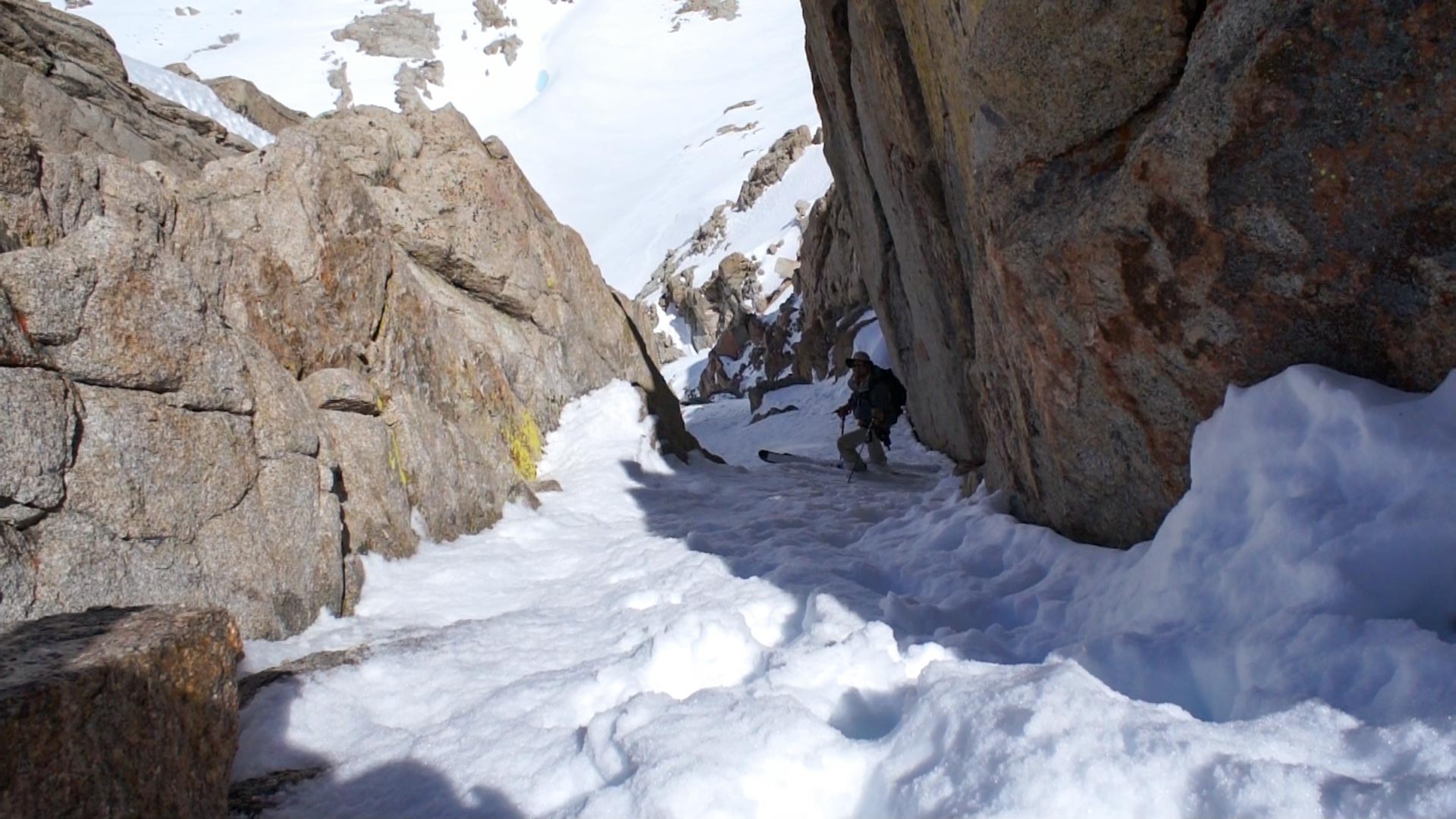
Dave Braun atop the Exit Couloir
The exit couloir, as the name implies, provides the essential function of escaping us from the hanging snowfields on Mount Muir's southeast face and connecting us (eventually) to the base of the mountain. Without it, we'd be needing parachutes to get down.
As exits go, however, I can most emphatically tell you this one leaves something to be desired.
Snow exists here at the margins of what is skiable, all of it hung high above the doomsday of the rock garden and other, nameless but most certainly not forgotten cliff zones below.
Here too, the route's aspect shifts from southeasterly to east and then northerly. That shift, plus the couloir's high, narrow walls, means the snow quality is far less friendly. Pockets of dry winter powder (which sticks to our wet ski bases) intermix with refreezing corn snow that is rapidly hardening in the shade of the couloir.
We go back to work, passing down and through the upper exit's choke point, down-climbing, skiing, or side-stepping as conditions and/or prudence (such as it is) dictate.
Below us waits the rock garden, ensuring that each and every move is an honest one.
To escape the cliff below the upper Exit Couloir, we must traverse back across the awful rock garden, thereafter rejoining the skiable lower part of the couloir, which will take us all the way through the remainder of the east buttress.
As I watch Dave cutting fearless turns above the dead-end cliff below, I can't help admiring his extraordinary skiing skills—on Tele gear no less!
In contrast to my quite a bit more timid and measured passage, Dave I must say is skiing the crap out of this couloir.
What I love about Dave as a ski mountaineering partner is that, whatever mad scheme I propose to him, he's always willing to give it a try. What I hate about Dave is that, whatever mad ski mountaineering scheme I propose to him, he's always willing to give it a try.
Beyond a doubt, however, it is our partnership that has made this day possible. Even the dreaded Rock Garden seems unlikely to stop us now.
Though I'm trying not to get ahead of myself, I'm starting to dare to dream we'll soon be standing at the base of this mountain, looking back up at the incredible tower of the east buttress, having completed the most unlikely and extraordinary ski descent of certainly my and perhaps even both our lives.
Over the Rainbow
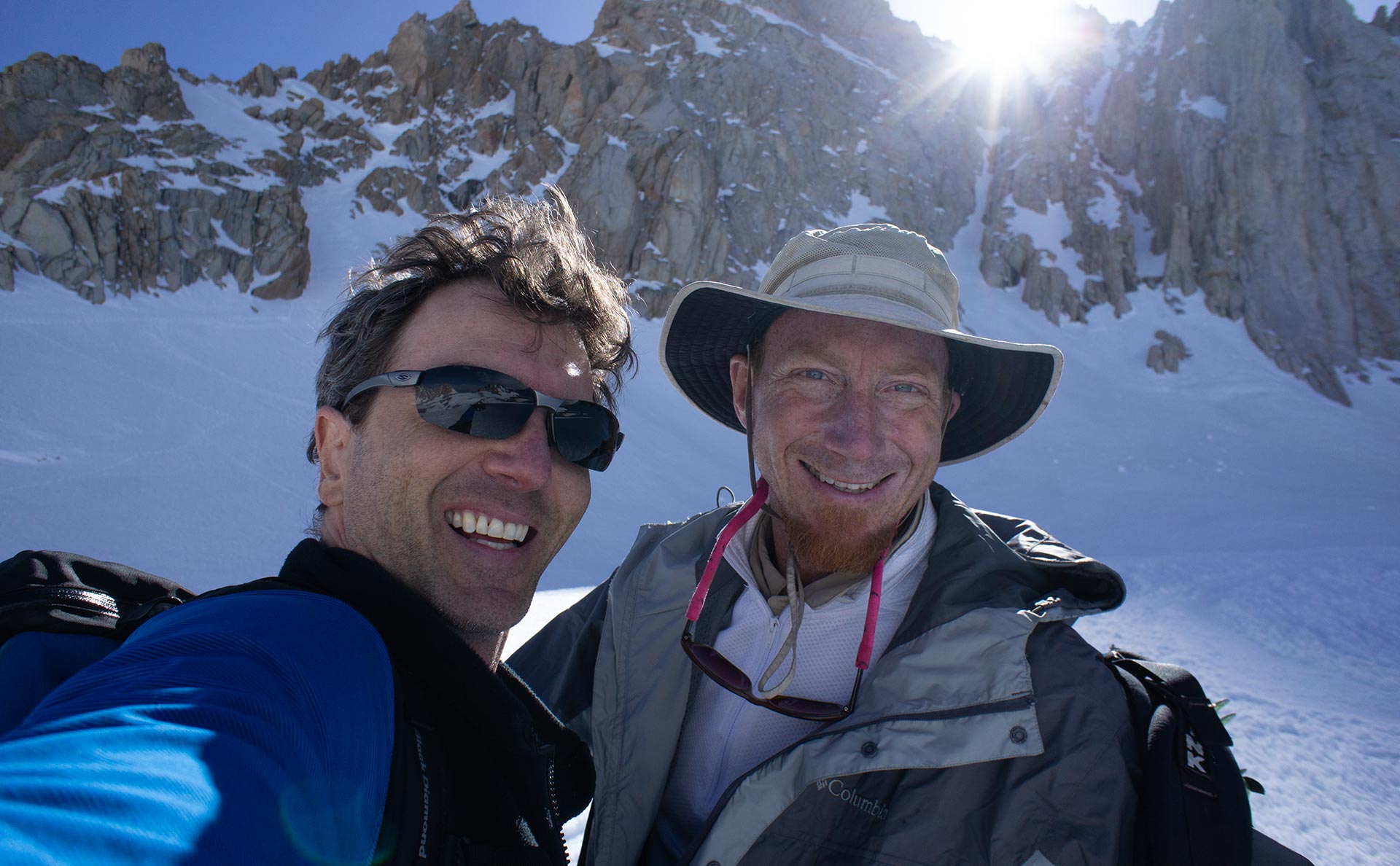
Andy Lewicky and David Braun
As we snap out of our skis in preparation for the rock garden, I suggest to Dave we pull out the rope. We've been carrying an 8mm Mammut; now seems like a fine time to put it to use.
Dave is curiously amenable to the suggestion, and soon we're rappelling off a marginal triangle of rock that has me wondering if maybe we'd be safer with the rope in the pack. A more secure belay materializes a moment later, and now I know it: we're going to pull this one off.
Waves of emotion surge through me as I unclip from the rope, down-climb back onto snow, and put my skis on for the last time. Relief and elation dominate, but I also feel very, very lucky. We've not just shaken a stick at the Reaper today; we've poked him in the eye with it.
Now that I'm safe, the image of my wife's face pops into my mind, and I am suddenly choking back tears.
But wait—let's finish the job at hand, first.
I stop and pull out my camera to shoot Dave's final turns. He passes me in great, sweeping arcs, each one dropping twenty vertical feet or more. The lower Exit Couloir, after all, remains impressively steep, but for the first time in a long while, the exposure below is no longer necessarily catastrophic.
There he goes—Dave's down past the apron, now emerging from the mountain's shadow onto the rolling moraines below.
My turn.
Are these not the sweetest turns I've ever made? The victory lap is steep and crusty at first, but I open it up as the pitch recedes, feel the wind rushing in my ears, my heart pounding in my chest. I ski right past Dave, shouting at the top of my lungs, then flinging my poles high in the air, tearing off my gloves and helmet, screaming back up at that mountain like a lunatic.
I walk back up to Dave, who is regarding me more than a little warily, and give him a big hug. "That was a hell of an adventure," I tell him. "Let's never do it again."
"Not until next time," Dave replies with a laugh.
And so it is over.
I suppose it would be nice if I could tell you that skiing Mount Muir somehow transformed my life. But the details, I find, are all exactly the same. I returned home to my small, cluttered Los Angeles apartment and my family and my joys and woes and all the pressures and problems of my daily existence—and not one bit of it was one bit different.
Though I can tell you, oddly enough, when I walked in the door, and saw my life in all its mundane detail, great and small, it was all suddenly precious to me in a way I hadn't noticed before—every last bit of it, dirty diapers and dishes included.
Dorothy was right: there is no place like home. Though whether or not that insight was worth the terrible price I might have paid to learn it is a question I can't answer.
